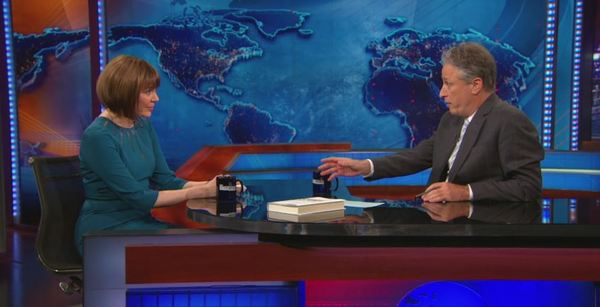The View From Mile 25: A Daily Show Taping in Jon Stewart’s Final Year
The Showclix website for reserving tickets to The Daily Show recommends that you not book a trip to New York City for the sole purpose of attending a taping of the show. The tickets you can get for free on the site are reservations, and if you don’t get in line early enough, you’re not guaranteed to get in. I booked the trip anyway. I wanted to see to Jon Stewart in person, doing what he’ll always be most known for, before he retired (or whatever he ends up doing after he leaves the show). NYC’s still a fun place to visit, after all.
For me and everyone else who’s put off going to see a live show, it’s now or never. Jon’s leaving the show in August, and tickets to The Daily Show are impossible to get unless you can be in NYC on short notice or, if you’re like me, get insomnia on just the right night and decide to check the Showclix site at five in the morning on a random day.
So we waited in line for hours, got our actual tickets, were told to come back in two hours, and went to Times Square for a little while. We got back, waited in line again, entered the building, waited in line again to enter the studio, waited for the warm-up comedian to hype the crowd, then finally, for Jon Stewart to do his thing, in his last year as host.
The Q&A with the crowd showed him at his most weary, mostly because it was clear he’d had to field a number of questions about his departure. But his leave is part of a much grander transition in the show’s life. His recent hires—Jessica Williams and Hasan Minhaj in particular—have been among the show’s best, and have helped assuage some of the programs’ diversity problems. These changes are all part of a larger shift in what the show will be after he’s gone. Jason Jones and Samantha Bee, two of the show’s longest-running correspondents, have moved on to create their own show. Writers and staff alike are making their own exits, writing for other late-night hosts or finding new avenues for their work. If you’re a fan, you can’t help but wonder what the show will be like by the end of the year.
As the face of the show, Stewart takes the brunt of the questions that amount to “why?”. How did the decision to leave the show to Trevor Noah come up? “Let me make something clear first. I don’t ‘hand’ the show to anyone,” Stewart said to the crowd at the taping I attended. It’s the network’s show, and they pick whoever they want, with his recommendation. He saw something in Noah and recommended him. You could tell he’s answered some form of this question every day since he announced.
If nothing else, he’s a consummate showman. You could read every bit of his routine as part of the Jon Stewart who interviewed with the Guardian after deciding he didn’t want to do the show anymore, putting on a smile for the cameras while watching the clock until it was time to punch out. But you could also read his performance as someone who doesn’t want to get to that point. The one who just wanted to see his kids more often. The one who’s inspired by an end date to do great things before he’s gone. “You don’t want to leave when the cupboard’s bare.”
![]()
Stewart may be leaving, in part, because of his increasing disillusionment with the political process, and the process of covering it—“Are there other ways to skin this cat?” and so forth—but at the taping I attended, he was in rare form. For the record, it was April 29th, 2015.
-

-

-

-

-

-

-

-

-

-

-

-

-

-

-

-

-

-

-

-

-

-

-

-

-

-

-

-

-

-

-

-

-

-

-

-

-

-

-

-









































